The e-commerce landscape is rapidly evolving, and businesses are continually seeking robust platforms to manage their online presence. Shopify has emerged as a leading commerce platform, hosting over 5.6 million active stores across more than 175 countries.
With a comprehensive suite of services including payments, marketing, shipping, and customer engagement tools, Shopify provides a complete solution for online retailers. The platform’s impressive growth is reflected in its 2023 revenue of $7.1 billion and a 20% increase in Gross Merchandise Volume to $235.9 billion.
This makes it an ideal choice for businesses of all sizes, from startups to enterprise-level operations, looking to establish or expand their online store.
Key Takeaways
- Shopify hosts over 5.6 million active stores globally.
- It offers a comprehensive suite of e-commerce services.
- The platform’s revenue reached $7.1 billion in 2023.
- Gross Merchandise Volume increased by 20% to $235.9 billion.
- Shopify caters to businesses of all sizes and growth stages.
Understanding Shopify’s E-Commerce Dominance
With its robust features and user-friendly interface, Shopify has established itself as a dominant force in e-commerce. Founded in 2006 by Tobias Lütke and Scott Lake, Shopify’s journey began with the creation of Snowdevil, an online store for snowboarding equipment, in 2004. Dissatisfied with existing e-commerce solutions, Lütke, a skilled computer programmer, decided to build his own platform using the open-source web application framework Ruby on Rails.
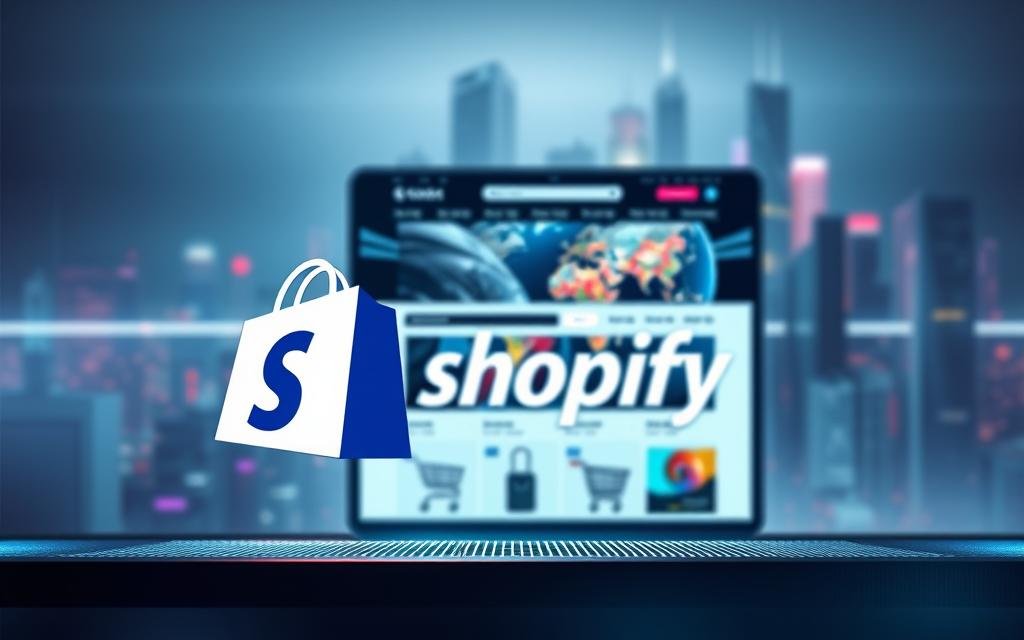
What Makes Shopify Stand Out in the E-Commerce Landscape
Shopify’s success can be attributed to its user-friendly interface and comprehensive feature set. The platform allows merchants to easily create and manage their online stores without requiring extensive technical knowledge. As Tobias Lütke noted, “Shopify is not just about building an online store; it’s about creating a comprehensive commerce platform that integrates various aspects of a business.” This vision has driven Shopify’s development and contributed to its widespread adoption.
The technical foundation of Shopify on Ruby on Rails has provided a solid framework for rapid development and scaling. This has enabled Shopify to adapt to changing market conditions and consumer expectations, maintaining its competitive edge in the e-commerce market.
Key Statistics and Market Position
Shopify has achieved a significant market position, becoming the second-largest publicly traded Canadian company. As of the latest reports, Shopify has processed substantial sales volume and boasts a large number of merchants on its platform. According to recent statistics, “Shopify’s global reach continues to expand, with merchants from various countries leveraging the platform to sell their products online.” This widespread adoption is a testament to Shopify’s marketing capabilities and its ability to cater to a diverse range of businesses.
The growth trajectory of Shopify is exceptional when compared to other e-commerce platforms. Its ability to scale and adapt has positioned it favorably in the competitive e-commerce landscape. As the e-commerce industry continues to evolve, Shopify’s commitment to innovation and customer satisfaction will likely maintain its dominance.
Core Features That Make Shopify the Leading Platform
By offering a wide range of intuitive and powerful features, Shopify has become the go-to e-commerce platform for businesses worldwide. This section will delve into the essential features that have propelled Shopify to the forefront of the e-commerce industry.
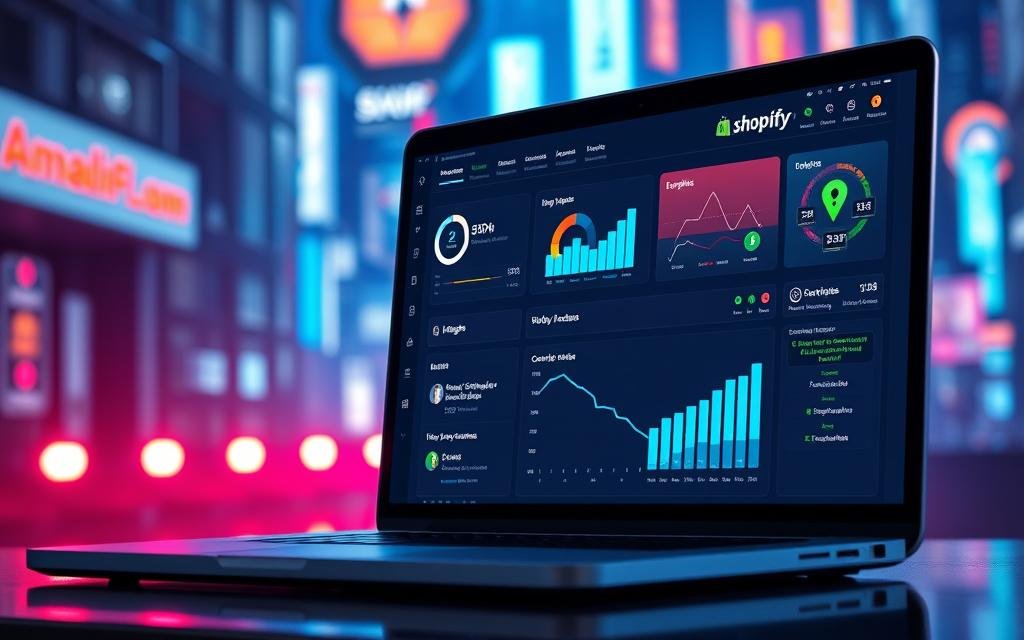
User-Friendly Store Creation and Management
Shopify’s drag-and-drop store builder and extensive template library enable merchants to create professional-looking online stores without requiring technical expertise. This user-friendly approach to store creation allows businesses to focus on sales and customer engagement rather than getting bogged down in complex web development.
The intuitive interface of Shopify’s control panel makes it easy to manage products, process orders, and analyze sales data. With features like customizable themes and a wide range of apps available, merchants can tailor their Shopify store to meet their specific business needs.
Secure and Reliable Payment Processing with Shop Pay
Shop Pay, Shopify’s proprietary payment processing system, has revolutionized the checkout experience with its one-click functionality. Launched in 2017 and rebranded in 2020, Shop Pay has garnered over 150 million users worldwide, making it a cornerstone of Shopify’s payment processing capabilities.
With its robust security features and streamlined checkout process, Shop Pay significantly reduces cart abandonment rates, leading to higher conversion rates for merchants. By integrating Shop Pay into their stores, businesses can offer their customers a faster, more secure checkout experience.
Comprehensive Inventory and Order Management
Shopify’s inventory management system allows merchants to track their stock levels in real-time across multiple sales channels and locations. This feature is crucial for maintaining accurate inventory levels and preventing overselling.
The order management system integrates seamlessly with inventory and shipping, creating a streamlined operational workflow. This integration enables merchants to efficiently process orders, manage shipping, and communicate with customers, all from within the Shopify platform.
By combining these core features, Shopify provides businesses with a comprehensive e-commerce solution that not only simplifies store management but also enhances the customer experience. As a result, merchants can focus on growth and customer engagement, leveraging Shopify’s robust platform to drive their success.
Shopify’s Customization Capabilities
Shopify’s extensive customization options empower merchants to create unique and branded shopping experiences. With a wide range of tools and features, businesses can tailor their online stores to reflect their brand identity.
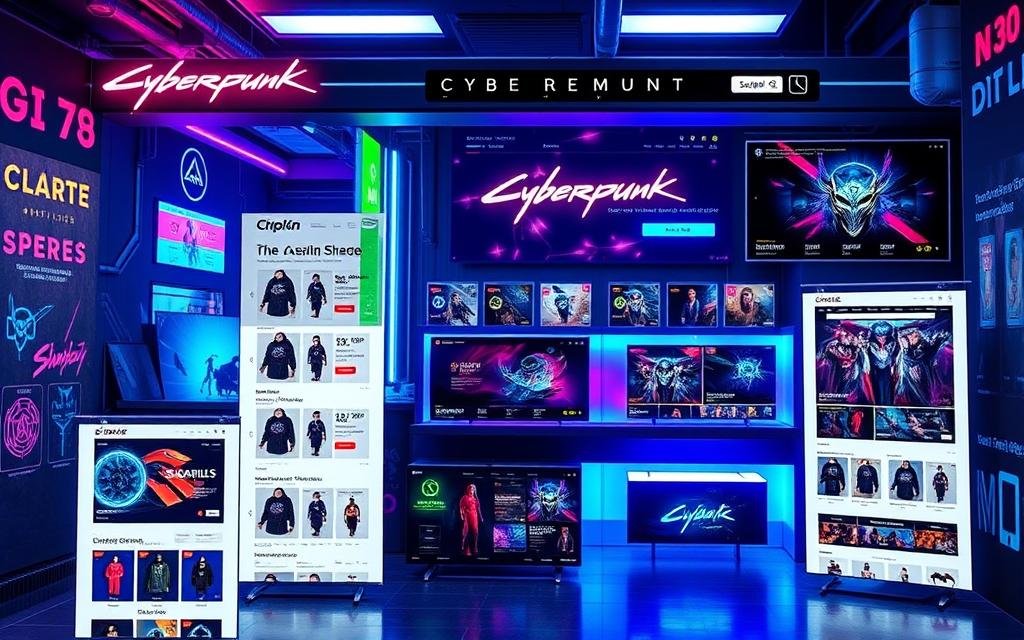
Theme Selection and Customization
Shopify’s theme marketplace offers hundreds of professional templates, ranging from free options to premium designs tailored for specific industries. This allows merchants to select a theme that closely matches their brand aesthetic.
The chosen theme can then be customized using Shopify’s intuitive tools, enabling businesses to modify layouts, colors, and fonts to create a unique store design.
Liquid: Shopify’s Powerful Templating Language
Liquid is Shopify’s open-source template language, written in Ruby and used since 2006. It enables developers to create dynamic and customized storefronts, providing a high degree of flexibility in store design.
With Liquid, merchants can create complex logic and dynamic content on their store pages, enhancing the overall shopping experience and making it feel more personalized.
Responsive Design for All Devices
Shopify themes are designed to be responsive, automatically adapting to different screen sizes and devices. This ensures that the shopping experience is optimal across desktops, tablets, and smartphones.
A responsive design is crucial for marketing efforts, as it directly impacts user engagement and conversion rates. By providing a seamless experience across all devices, businesses can effectively market their products to a wider audience.
By leveraging these customization capabilities, merchants can create stores that feel like unique brand experiences, rather than generic template-based websites. Effective customization not only enhances the aesthetic appeal of the store but also plays a crucial role in marketing strategies, ultimately driving sales and customer loyalty.
Moreover, balancing customization with performance is key. While adding features and complex designs can enhance the user experience, it’s essential to monitor loading speeds and ensure that the store remains responsive and fast.
The Shopify App Ecosystem
Shopify’s commitment to its app ecosystem has resulted in a thriving marketplace with thousands of apps catering to diverse merchant requirements. Launched on June 2, 2009, the Shopify App Store has evolved significantly over the years, now featuring over 10,000 applications that extend the platform’s core functionality.
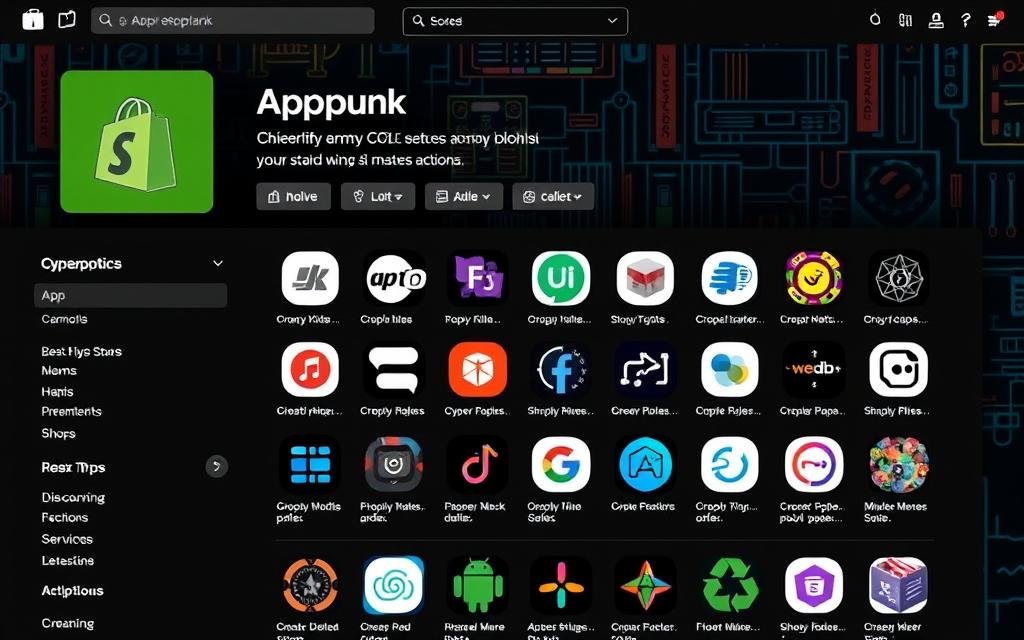
Essential Apps for Store Enhancement
The average Shopify merchant uses six apps to manage their business, indicating the importance of these tools in enhancing store operations. Essential apps can be categorized into several key areas, including inventory management, customer service, and marketing.
For inventory management, apps like Inventory Planner and Stock Sync help merchants streamline their stock levels and automate inventory updates.
Customer service can be significantly improved with apps such as Gobot and ReConvert, which offer chatbots and post-purchase engagement tools.
Marketing and SEO Applications
Marketing and SEO are crucial for driving traffic and increasing conversion rates. Shopify offers a range of marketing and SEO applications to help merchants achieve these goals.
Popular marketing apps include AdRoll for retargeting campaigns and Mailchimp for email marketing automation.
For SEO, apps like SEO Booster and SiteBoost provide tools to optimize product pages and improve site visibility.
Customer Service and Engagement Tools
Building strong customer relationships is vital for repeat business. Shopify’s customer service and engagement tools help merchants achieve this.
Apps such as ReConvert and Gobot not only enhance customer service but also encourage repeat purchases through personalized engagement.
Shopify’s developer-friendly policies, including the decision to eliminate commissions on the first million dollars earned by app developers in 2021, have fostered a vibrant app ecosystem.
When selecting apps, merchants should consider their specific business needs and avoid app overload, which can slow down store performance.
Setting Up Your Shopify Store: A Step-by-Step Guide
Shopify’s intuitive platform makes it simple to set up a fully functional online store, and we’re here to guide you through it.

Creating Your Shopify Account
The first step in setting up your Shopify store is creating an account. Navigate to Shopify’s website and click on the “Get started” button. You’ll be prompted to enter your email address, create a password, and provide some basic information about your business.
Shopify offers a 14-day free trial, allowing you to explore the platform and set up your store without immediate financial commitment. Choose a plan that suits your business needs, from the Basic Shopify plan to the Advanced Shopify plan, each offering different features and support levels.
Choosing and Customizing Your Theme
Once your account is set up, it’s time to choose a theme for your online store. Shopify offers a wide range of free and paid themes that are fully customizable. Browse the Shopify Theme Store, considering factors like responsiveness, layout, and overall design aesthetic that aligns with your brand.
After selecting a theme, you can customize it using Shopify’s theme editor. This involves adjusting colors, fonts, and layouts without requiring extensive coding knowledge. You can also add custom sections and blocks to create a unique look for your store.
Adding Products and Collections
With your theme in place, the next step is to add products to your Shopify store. This involves uploading product images, writing detailed descriptions, setting prices, and configuring inventory options. Organize your products into collections to improve navigation and customer experience.
For each product, you can specify details like variant options, pricing, and shipping information. Shopify also allows you to add product reviews and other customer engagement features to enhance your store’s interactivity.
Setting Up Payment and Shipping Options
To complete your store setup, you need to configure payment and shipping options. Shopify Payments is a built-in payment gateway that simplifies transaction processes. You can also integrate third-party payment providers to offer customers a range of payment methods.
For shipping, create shipping zones, set rates, and integrate with fulfillment services to streamline your order fulfillment process. Shopify supports various shipping carriers and offers calculated shipping rates to ensure accurate costs are passed on to customers.
Optimizing Your Shopify Store for Conversions
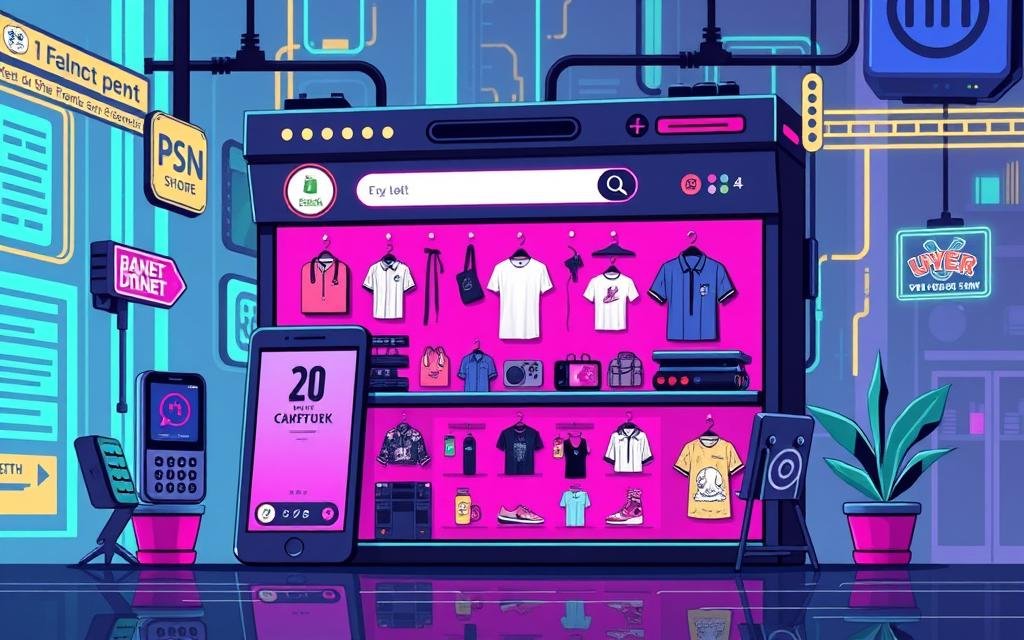
Maximizing conversions on your Shopify store requires a strategic approach to store design and functionality. With the right optimization techniques, you can significantly increase your conversion rates and drive business growth.
Effective Product Page Design
A well-designed product page is crucial for converting visitors into customers. To achieve this, focus on using high-quality images that showcase your products from different angles. Ensure that your product descriptions are compelling and detailed, providing customers with the information they need to make a purchase.
Clear pricing and strategic placement of add-to-cart buttons can also enhance the shopping experience. Consider using social proof elements like customer reviews and testimonials to build trust and encourage purchases.
Streamlining the Checkout Process
A streamlined checkout process is vital for reducing cart abandonment rates. Shopify’s recent acquisition of Checkout Blocks enables merchants to customize their checkout experience with no-code customizations. This means you can personalize the checkout process to fit your brand’s needs, improving the overall customer experience.
To further optimize the checkout process, consider reducing the number of steps required to complete a purchase. Use clear and concise language on your checkout buttons and provide guest checkout options to simplify the process.
Implementing Abandoned Cart Recovery
Abandoned cart recovery is a critical strategy for re-engaging customers who have left your store without completing a purchase. Shopify allows you to set up automated email sequences that remind customers about their abandoned carts.
To maximize the effectiveness of your abandoned cart recovery efforts, personalize your emails with product recommendations and special offers. This can encourage customers to return to your store and complete their purchase.
By implementing these optimization strategies, you can significantly improve your Shopify store’s conversion rates. Remember to continuously monitor your store’s performance using Shopify’s analytics tools and make data-driven decisions to further optimize your store.
Marketing Your Shopify Store
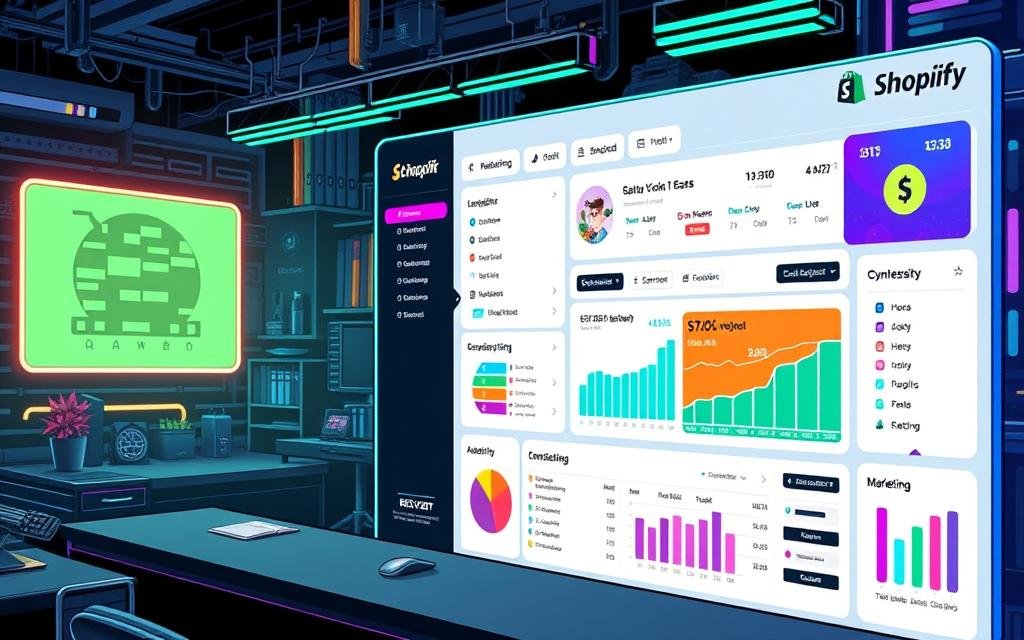
Marketing your Shopify store is a multifaceted process that involves various strategies and tools. To drive qualified traffic and boost sales, you need to leverage the right marketing techniques. Shopify provides a range of built-in features and integrations that can help you promote your store effectively.
Built-in SEO Tools and Best Practices
Search Engine Optimization (SEO) is critical for increasing your store’s visibility on search engines like Google. Shopify offers several built-in SEO tools to help you optimize your store. These include customizable meta tags, automatic sitemap generation, and URL structure optimization. By using these features, you can improve your store’s search engine ranking and drive organic traffic.
To maximize your SEO efforts, follow best practices such as using relevant keywords in your product descriptions and meta tags, optimizing your images, and creating high-quality content. Regularly updating your content and using header tags (H1, H2, H3) can also enhance your store’s SEO.
Email Marketing with Shopify
Email marketing is a powerful way to connect with your customers and promote your products. Shopify Email is a native email marketing solution that allows you to create and send targeted campaigns directly from your Shopify dashboard. You can integrate your product catalog and customer database to create streamlined campaigns.
Shopify also supports third-party email marketing integrations like Klaviyo, which received a $100 million strategic investment from Shopify in 2022. These integrations offer advanced features and analytics to help you optimize your email marketing efforts.
Social Media Integration and Selling
Social media is a vital channel for reaching new customers and promoting your products. Shopify has partnered with various social media platforms, including Facebook, Instagram, and Twitter, to provide seamless integration and selling capabilities. You can set up shoppable posts and synchronize your inventory across multiple sales channels.
In 2022, Shopify partnered with Twitter to launch a sales channel app for U.S. merchants. Although Shopify’s partnership with TikTok was discontinued in 2023, the platform still offers various social media integrations to help you expand your reach.
To create a cohesive multi-channel marketing strategy, maintain consistent branding across all platforms while leveraging the unique advantages of each. Use Shopify’s analytics and attribution tools to measure the effectiveness of your marketing efforts and make data-driven decisions.
Scaling Your Business with Shopify
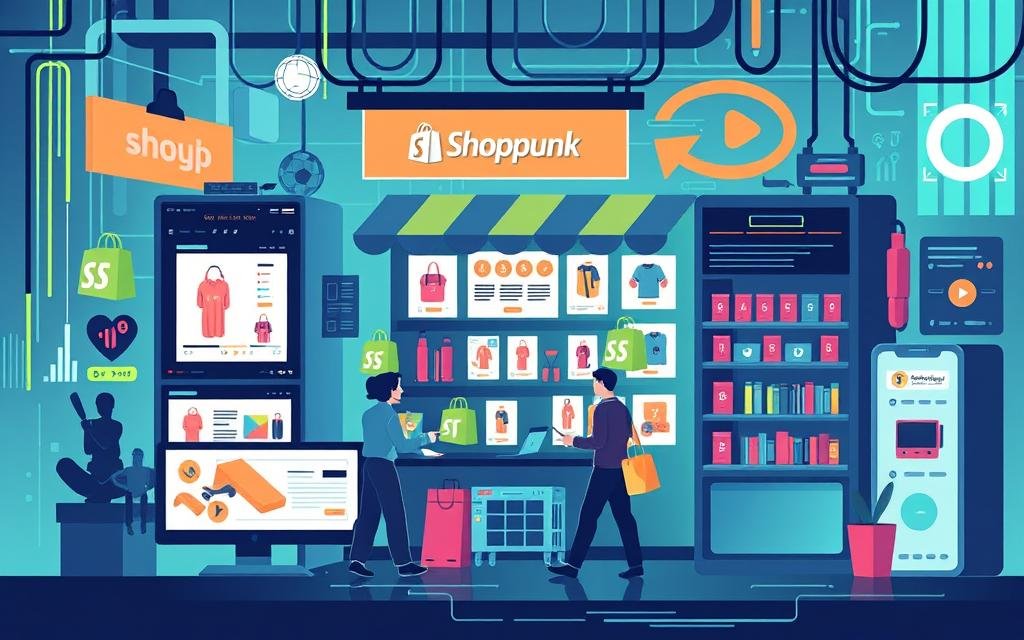
As businesses grow, they require more robust e-commerce solutions, and Shopify provides the necessary tools to scale effectively. With a range of features designed to support expansion, Shopify is an ideal platform for businesses looking to increase their online presence and sales.
Shopify Plus for Enterprise-Level Businesses
Shopify Plus, launched in February 2014, is designed for large e-commerce businesses seeking additional features and support. This enterprise-level solution offers advanced capabilities, including higher API call limits, dedicated support, and customizable checkout processes, making it an attractive option for high-volume merchants.
Key Benefits of Shopify Plus:
- Advanced automation capabilities
- Dedicated support for priority assistance
- Higher API call limits for increased flexibility
- Customizable checkout for a tailored customer experience
By leveraging these features, businesses can streamline their operations, improve customer satisfaction, and drive growth.
International Expansion Capabilities
Shopify offers a range of tools to facilitate international expansion, enabling merchants to sell globally. Features include multi-currency selling, language translation options, and localized payment methods, making it easier for businesses to adapt to different markets.
Strategies for International Expansion:
- Understand local regulations and compliance requirements
- Adapt your store for different cultural preferences
- Optimize shipping logistics for timely delivery
By utilizing these strategies, businesses can successfully expand into new markets and increase their global reach.
Multichannel Selling Strategies
Multichannel selling is crucial for businesses looking to maximize their sales potential. Shopify enables merchants to sell across various channels, including online marketplaces, social media platforms, and physical retail locations, all managed from a single dashboard.
Benefits of Multichannel Selling:
- Increased brand visibility across multiple platforms
- Improved customer engagement through diverse sales channels
- Streamlined inventory management and order fulfillment
By adopting a multichannel selling approach, businesses can diversify their sales streams and enhance their overall marketing strategy.
Shopify Analytics and Reporting
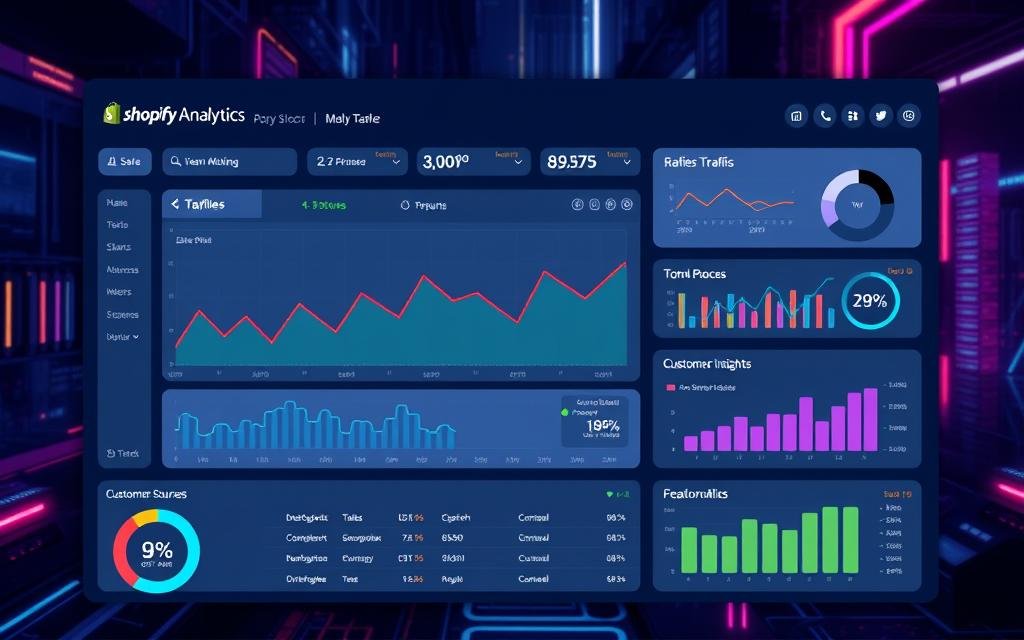
Understanding your store’s strengths and weaknesses is key to optimizing its performance on Shopify. To achieve this, Shopify offers a robust analytics and reporting system that provides merchants with actionable insights into their store’s performance.
Key Performance Metrics
Shopify’s analytics dashboard offers a comprehensive overview of your store’s performance, including sales data, visitor information, conversion rates, average order value, and customer retention statistics. These metrics are crucial for identifying areas of improvement and opportunities for growth.
For instance, analyzing your conversion rates can help you understand how effectively your store is turning visitors into customers. Similarly, tracking your average order value can inform your pricing and product bundling strategies.
Data-Driven Decision Making
Shopify’s analytics capabilities extend beyond basic metrics, allowing merchants to make informed decisions about their business. By leveraging data on customer behavior and sales trends, you can optimize your marketing strategies, improve inventory management, and enhance customer satisfaction.
For example, Shopify offers courses like “Grow your Business with Data Analysis” that teach merchants how to draw insights from data to better inform their business decisions. This includes understanding customer motivations and behavior, which can lead to more effective marketing and product development strategies.
To further enhance your analytics capabilities, you can set up enhanced e-commerce tracking with Google Analytics. This provides more detailed insights into visitor behavior, allowing for a more nuanced understanding of your store’s performance.
Creating custom reports focused on specific KPIs relevant to your business goals is also possible within Shopify. This enables you to track the metrics that matter most to your business, making it easier to identify trends and areas for improvement.
Shopify Pricing and Plans Comparison
Selecting the right Shopify plan is a critical decision for merchants aiming to optimize their e-commerce operations. Shopify offers multiple pricing tiers, including Basic, Shopify, and Advanced plans for small to medium businesses, and Shopify Plus for enterprise-level operations.
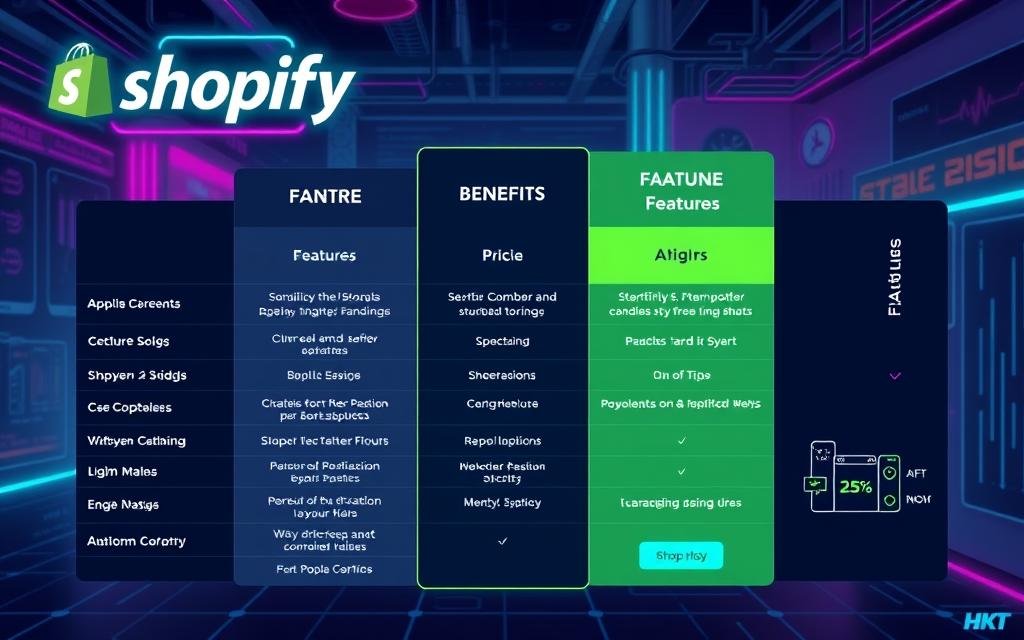
Basic, Shopify, and Advanced Plans
The Basic Shopify plan is ideal for new businesses or those with limited sales volume. It includes essential features such as unlimited products and a storefront, but has limitations on staff accounts and advanced reporting.
The Shopify plan is the most popular choice among merchants, offering additional features like gift cards and professional reports, making it suitable for growing businesses.
The Advanced Shopify plan is designed for businesses with higher sales volumes or more complex needs, providing advanced features like third-party calculated shipping rates and detailed reporting.
Shopify Plus for Enterprise Businesses
Shopify Plus is tailored for large-scale businesses and enterprises, offering a robust set of features including Shopify Flow for automation and Script Editor for checkout customization. The pricing for Shopify Plus typically starts around $2,000 per month but can vary based on sales volume.
Shopify Plus merchants also benefit from dedicated account management and support, making it an attractive option for businesses requiring high-level service and customization.
Shopify POS: Bridging Online and Offline Sales

The Shopify POS system is designed to bridge the gap between online and offline sales, providing a unified retail experience. This integration enables merchants to manage their entire business from a single platform, simplifying operations and enhancing customer satisfaction.
Hardware and Software Components
Shopify POS comprises both hardware and software components that work together to facilitate seamless transactions. The hardware includes the Chip & Swipe Reader, a Bluetooth-enabled card reader introduced in April 2017, and the Retail Stand, which is similar to those offered by other POS providers like Square.
The software component is equally robust, featuring a user-friendly interface that allows for efficient checkout processes, staff management, and inventory tracking. The Shopify POS mobile app enables merchants to process transactions on-the-go, making it ideal for businesses that operate at multiple locations or events.
Unified Inventory and Customer Management
One of the key benefits of Shopify POS is its ability to integrate with the online store, providing a unified inventory management system. This means that inventory levels are updated in real-time across all sales channels, reducing the risk of overselling and improving order fulfillment.
Additionally, Shopify POS offers comprehensive customer management features. Merchants can create detailed customer profiles that combine both online and in-store purchase history. This unified view enables personalized marketing and improved customer service, regardless of where purchases are made.
For instance, a retailer can use the customer data to offer targeted promotions, enhancing the shopping experience and encouraging repeat business. The ability to access a customer’s purchase history across different channels allows staff to provide a more personalized service, improving customer loyalty.
Shopify POS also allows businesses to compare their online and offline sales performance within a single dashboard, providing valuable insights into customer behavior and sales trends. This data can be used to optimize marketing strategies and improve overall business performance.
Shopify Support and Community Resources

Shopify’s support and community resources provide a solid foundation for merchants to build and grow their online stores. With a comprehensive support system in place, merchants can overcome challenges and achieve their business goals.
24/7 Customer Support Options
Shopify offers 24/7 customer support through various channels, including live chat, email, and phone support. This ensures that merchants can get help whenever they need it, regardless of their plan level.
The support access varies by plan, with higher-tier plans receiving priority support and dedicated account managers. This tiered support system allows Shopify to cater to the diverse needs of its merchants.
Educational Resources and Community Forums
Shopify provides extensive educational resources, including the Help Center, blog, guides, tutorials, and Shopify Academy courses. These resources empower merchants to develop their skills and stay updated on the latest e-commerce trends.
The Shopify Community forums offer a platform for merchants to connect with peers, share experiences, and seek advice on common challenges. Additionally, the Shopify Partner Directory connects merchants with certified experts who can provide specialized assistance with store development and optimization.
By leveraging these support resources, merchants can not only resolve immediate issues but also develop long-term skills to drive their business forward. Whether you’re just starting out or scaling your business, Shopify’s support ecosystem is designed to help you succeed.
Case Studies: Successful Businesses Using Shopify
With millions of active stores across more than 175 countries, Shopify has established itself as a leading e-commerce platform for businesses of all sizes. The success stories of Shopify merchants span various industries, showcasing the platform’s versatility and capability to support diverse business needs.

Growing Small Businesses
Many small businesses have leveraged Shopify to grow from startups to sustainable operations. For instance, a fashion boutique was able to increase its online sales by 300% within six months by utilizing Shopify‘s user-friendly store creation tools and integrating marketing apps.
| Business Type | Growth Achieved | Key Shopify Features Used |
|---|---|---|
| Fashion Boutique | 300% increase in sales | Store creation tools, marketing apps |
| Food and Beverage | 200% increase in online orders | Inventory management, gift card apps |
| Home Goods | 150% increase in sales | Responsive themes, customer review apps |
These small businesses exemplify how Shopify supports growth through its comprehensive ecosystem, including various apps and Shopify partners that enhance the overall shopping experience.
Enterprise-Level Success Stories
For larger enterprises, Shopify Plus offers advanced features and scalability. A notable example is a global electronics brand that migrated to Shopify Plus and saw a significant improvement in handling high-volume sales during peak seasons.
The brand leveraged Shopify‘s API capabilities and customization options to streamline their operations and improve customer satisfaction. This strategic move not only enhanced their e-commerce capabilities but also allowed them to integrate with plus partners for further optimization.
| Enterprise | Key Benefits | Shopify Plus Features Utilized |
|---|---|---|
| Global Electronics Brand | Improved scalability, enhanced customer satisfaction | API capabilities, customization options |
| Fashion Retailer | Increased sales, better inventory management | Advanced inventory management, omnichannel selling |
These enterprise-level success stories highlight Shopify‘s ability to support complex operations and high-volume sales, making it a preferred choice for large businesses. The platform’s flexibility and the support of Shopify partners enable these businesses to achieve their goals efficiently.
Shopify vs. Competitors: A Detailed Comparison
In the world of online commerce, choosing the right platform is crucial; this comparison will help you decide between Shopify and other top e-commerce platforms.

WooCommerce Comparison
Shopify and WooCommerce are two popular e-commerce solutions that cater to different business needs. While Shopify is a standalone e-commerce platform, WooCommerce is a plugin for WordPress, offering flexibility for users already invested in the WordPress ecosystem.
Pricing Structure: Shopify operates on a subscription-based model, with plans starting at $29 per month. In contrast, WooCommerce is free to download, but users must pay for hosting, themes, and potentially extensions, which can vary in cost.
Ease of Use: Shopify is generally considered more user-friendly, especially for those without web development experience. WooCommerce, while user-friendly for WordPress users, requires more technical knowledge to fully customize and manage.
BigCommerce Comparison
BigCommerce is another SaaS e-commerce platform that competes directly with Shopify. Both offer a range of features and scalability, but there are key differences in their approaches to pricing, SEO, and enterprise solutions.
Pricing: BigCommerce pricing plans are competitive with Shopify, starting at $29 per month. However, BigCommerce is known for not charging commission on sales, which can be a significant cost savings for larger businesses.
SEO Capabilities: Both platforms offer robust SEO tools, but BigCommerce is often praised for its more comprehensive built-in SEO features, giving it a slight edge in search engine rankings.
Magento Comparison
Magento, now known as Adobe Commerce, is an open-source e-commerce platform that offers high levels of customization and scalability, making it a favorite among larger enterprises.
Technical Requirements: Magento requires significant technical expertise to implement and manage, often necessitating a team of developers. Shopify, on the other hand, is more accessible to businesses without extensive technical resources.
Total Cost of Ownership: While Magento itself is free, the total cost of ownership, including development, maintenance, and hosting, can be substantial. Shopify’s subscription model provides a more predictable cost structure.
When choosing an e-commerce platform, it’s essential to consider your business needs, technical expertise, and growth plans. Each platform has its strengths and weaknesses, and the right choice will depend on your specific circumstances.
Common Challenges and Solutions When Using Shopify
Despite its popularity, Shopify users often encounter technical and optimization challenges that require practical solutions. While Shopify is generally user-friendly, merchants may face issues related to theme customization, app conflicts, checkout limitations on lower-tier plans, and performance optimization with multiple apps installed.
These challenges can significantly impact a store’s performance and conversion rates. In this section, we’ll explore the most common difficulties that merchants face when using Shopify and provide actionable solutions to overcome them.
Technical Issues and Troubleshooting
Technical issues are a common challenge for Shopify merchants. These can range from theme customization limitations to app conflicts and integration problems with third-party services.
- Theme Customization Limitations: While Shopify offers a wide range of customizable themes, there may be limitations to how much you can alter the design without coding knowledge.
- App Conflicts: With thousands of apps available in the Shopify App Store, conflicts between apps or with the theme can occur, potentially causing site instability.
- API Rate Limits: Shopify has API rate limits in place to ensure fair usage. Merchants using multiple apps or services that make frequent API calls may hit these limits, causing issues.
To troubleshoot these technical issues, merchants can follow step-by-step guides or seek help from Shopify support or developers. For instance, when experiencing app conflicts, try disabling recently installed apps to identify the source of the issue.
Optimization and Performance Challenges
Optimization and performance challenges are another significant concern for Shopify merchants. These include slow-loading pages, image optimization, and managing multiple apps to improve site speed.
To address these challenges, merchants can implement several strategies:
- Image Optimization: Compressing images can significantly reduce page load times. Tools like TinyPNG can help achieve this without compromising image quality.
- App Management: Regularly reviewing installed apps and removing unnecessary ones can improve site performance. Some apps, even when not in use, can still affect site speed.
- Checkout Customization: For merchants on lower-tier plans, checkout customization is limited. However, there are workarounds and app solutions available that can enhance the checkout experience.
By understanding these common challenges and implementing the suggested solutions, Shopify merchants can optimize their stores for better performance and improved customer satisfaction.
Additionally, maintaining accurate inventory levels across multiple sales channels is crucial. Merchants can achieve this by using inventory management apps that sync stock levels across different platforms.
Payment processing issues can also affect conversion rates. Diagnosing these issues involves checking payment gateway settings, ensuring correct API keys are used, and testing different payment methods.
Finally, optimizing the store structure for better search engine visibility is essential. This includes using relevant keywords in product titles and descriptions, optimizing meta tags, and ensuring a clear site structure.
Future of E-Commerce with Shopify
Shopify’s commitment to innovation is shaping the future of e-commerce, enabling businesses to thrive in a rapidly changing landscape. As the e-commerce industry continues to evolve, Shopify remains at the forefront, driving growth and setting new standards for online commerce.
In 2025, Shopify announced a significant milestone in its technological roadmap: the migration of all its apps to React Native over the last five years. This strategic move allows for a unified codebase across different client platforms, ensuring a consistent and seamless experience for users. Furthermore, Shopify continues to innovate with technologies like Hydrogen, a headless commerce framework that offers merchants flexibility and performance enhancements.
Upcoming Features and Innovations
Shopify’s technological advancements are not limited to React Native and Hydrogen. The platform is also investing heavily in marketing automation, a crucial aspect for businesses aiming to streamline their marketing efforts and improve customer engagement. With these innovations, Shopify is poised to support merchants in navigating the complexities of modern e-commerce.
One of the key areas of focus for Shopify is the integration of emerging technologies into its platform. For instance, augmented reality (AR) shopping is becoming increasingly popular, allowing customers to interact with products in a more immersive way. Shopify is working to incorporate AR capabilities, enabling merchants to offer their customers a more engaging shopping experience.
- Enhanced support for voice commerce, allowing for more intuitive shopping experiences
- Advanced social commerce features, integrating shopping capabilities directly into social media platforms
- Improved marketing automation tools, helping businesses to personalize their marketing efforts
Adapting to E-Commerce Trends with Shopify
The e-commerce landscape is constantly evolving, with new trends and consumer behaviors emerging regularly. Shopify is committed to adapting to these changes, ensuring that its platform remains relevant and effective for merchants. One of the significant trends is the shift towards omnichannel retail, where businesses aim to provide a seamless shopping experience across online, mobile, and physical channels.
Shopify is addressing this trend by enhancing its omnichannel capabilities, including its Shopify POS system, which bridges online and offline sales. Additionally, the platform is exploring new payment methods, such as cryptocurrencies and buy-now-pay-later services, to cater to the diverse needs of consumers.
As privacy changes continue to impact digital marketing, Shopify is developing solutions to help merchants navigate the post-cookie tracking landscape. By staying ahead of these changes, Shopify enables businesses to maintain effective marketing strategies while respecting consumer privacy.
By leveraging Shopify’s innovative features and staying informed about the latest e-commerce trends, merchants can position themselves for success in a rapidly evolving market.
Conclusion
In conclusion, Shopify emerges as the premier e-commerce platform for businesses of all sizes due to its robust feature set and scalability. Throughout this article, we’ve explored the various aspects that make Shopify an ideal choice for merchants looking to establish a strong online presence.
One of the key reasons Shopify stands out is its comprehensive suite of tools that cater to all aspects of e-commerce, from creating and customizing an online store to managing inventory and processing payments securely. The platform’s user-friendly interface ensures that even beginners can easily set up and manage their store without needing extensive technical knowledge.
For growing businesses and advanced users, Shopify offers powerful capabilities, including a vast ecosystem of apps and themes that can be integrated to extend the platform’s functionality. Whether it’s enhancing marketing efforts through SEO tools and social media integration or improving customer service with specialized apps, Shopify provides the flexibility to adapt to evolving business needs.
Shopify’s commitment to innovation and staying abreast of e-commerce trends positions merchants for long-term success. The platform’s continuous updates and new features ensure that businesses using Shopify can leverage the latest technologies and best practices in e-commerce.
Scalability is another significant advantage of Shopify, with plans ranging from entry-level to enterprise solutions like Shopify Plus, which supports high-volume global businesses. This scalability, combined with the platform’s extensive support resources, including Shopify Partner programs, makes it an attractive option for businesses at any stage of growth.
For businesses considering Shopify, whether you’re just starting out or looking to migrate from another platform, the key takeaway is that Shopify offers a unique blend of ease of use, comprehensive features, and scalability. By choosing Shopify, merchants can focus on growing their business, confident in the knowledge that their e-commerce platform can adapt to their evolving needs.
In summary, Shopify is more than just an e-commerce platform; it’s a comprehensive solution that supports businesses from inception through to global expansion. With its robust feature set, extensive ecosystem, and commitment to innovation, Shopify is undoubtedly the best choice for Shopify merchants and businesses looking to thrive in the competitive world of e-commerce.
